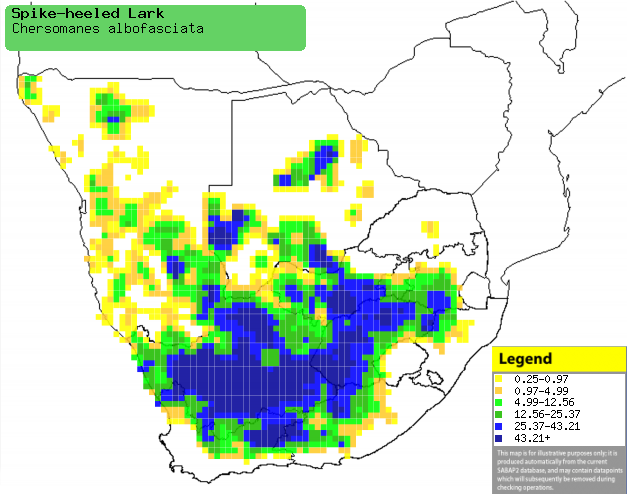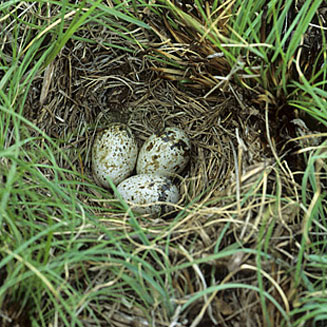|
Chersomanes albofasciata
(Spike-heeled lark)
Vlaktelewerik [Afrikaans]; Ungqembe, Ungqwembe [Xhosa];
Sjirpleeuwerik [Dutch]; Alouette éperonnée [French]; Zirplerche
[German]; Cotovia-esporada [Portuguese]
Life
> Eukaryotes >
Opisthokonta
> Metazoa (animals) >
Bilateria >
Deuterostomia > Chordata >
Craniata > Vertebrata (vertebrates) > Gnathostomata (jawed
vertebrates) > Teleostomi (teleost fish) > Osteichthyes (bony fish) > Class:
Sarcopterygii (lobe-finned
fish) > Stegocephalia (terrestrial
vertebrates) > Tetrapoda
(four-legged vertebrates) > Reptiliomorpha > Amniota >
Reptilia (reptiles) >
Romeriida > Diapsida > Archosauromorpha > Archosauria >
Dinosauria
(dinosaurs) > Saurischia > Theropoda (bipedal predatory dinosaurs) >
Coelurosauria > Maniraptora > Aves
(birds) > Order: Passeriformes
> Family: Alaudidae
Distribution and habitat
Near-endemic to southern Africa, occurring from
south-western Angola through to Namibia, Botswana and South Africa. It generally
prefers sparse grassland, desert grassland and shrubland, generally avoiding
croplands and cultivated pastures.
|
 |
|
Distribution of Spike-heeled lark in southern Africa,
based on statistical smoothing of the records from first SA Bird Atlas
Project (©
Animal Demography unit, University of
Cape Town; smoothing by Birgit Erni and Francesca Little). Colours range
from dark blue (most common) through to yellow (least common).
See here for the latest distribution
from the SABAP2. |
Predators and parasites
It has been recorded as prey of the following animals:
Food
It mainly eats invertebrates and seeds, doing most of its
foraging in the ground, plucking food from the soil surface or from the bases of
grasses and forbs. It often looks for food around rodent burrows, and it may
even take prey aerially or from the leaves of shrubs. The following food items have been recorded
in its diet:
Breeding
- The nest (see image below) is built by both sexes in about 5 days,
consisting of a open cup built of dry grass, twigs and rootlets. It is
typically placed in an shallow excavated hole in the ground, usually at the
base of a grass tuft or shrub. In arid areas it is often placed in a clump
of stones and sticks; facing south or east to maximise shade in the heat of
the day.
 |
|
|
Spike-heeled lark nest with eggs, Wakkerstroom,
South Africa. [photo Warwick Tarboton ©] |
|
- It often lays its eggs in response to rainfall, with the egg-laying season
generally peaking around August-December.
- It lays 2-3 sometimes up to 5 eggs (only after heavy rainfall), which
are incubated solely by the female for about 12-13 days.
- The chicks are fed by both parents, leaving the nest after about 8-12
days, before they are able to fly. They usually become independent a few
days later.
Threats
Not threatened.
References
-
Hockey PAR, Dean WRJ and Ryan PG 2005. Roberts
- Birds of southern Africa, VIIth ed. The Trustees of the John Voelcker
Bird Book Fund, Cape Town.
|
